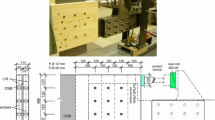Abstract
The EC-5 is the European Structural Standard which develops the design of timber structures. One of its principal aims is to give the engineers the rules to design the connections that are used in these kind of structures. Dowel-type fasteners are one of the most extended kind of joints that can appear, and they work in single or in double shear. The focus of this research is to study the design stresses in this last case. The results obtained using the rules included in the official standard will be compared with those arising from the finite element method. The interaction between stresses and other variables such as geometry, section and material will be presented, as well as an analysis of the results.




















Similar content being viewed by others
References
United States Department of Agriculture (1998) Wood handbook—wood as an engineering material. USDA, Forest Service, Forest Products Laboratory, Madison
Johansen KW (1949) Theory of timber connections. Int Assoc Bridge Struct Eng Publ 9:249–262
Batchelar ML, Mcintosh KA (1988) Structural joints in glulam. In: Proceedings of the 5th world conference in timber engineering, Montreux, August 1988
Hilson BO (1995) Joints with dowel-type fasteners. Theory. Timber engineering, STEP 1. Centrum Hout, Holland
Davis TJ, Claisse PA (2000) Bolted joints in glulam and structural timber composites. Construct Build Mater 14:407–417
Eurocode 5 (2004) Design of timber structures. Part 1-1. EN 1995-1-1. European Committee for Standardization, Brussels
Chen CJ, Lee TL, Jeng DS (2003) Finite element modelling for the mechanical behaviour of dowel-type timber joints. Comput Struct 81:2731–2738
UNE EN 338 (1995) Madera estructural. Clases resistentes. Ministerio de Fomento. Madrid
Blanchet P (2004) Caractérisation du comportement des lames de plancher d’ingénierie. Faculté de foresterie et de géomatique. Université Laval. Québec. Ph.D. Thesis
Williams JM, Fridley KJ, Cofer WF, Falk RH (2000) Failure modelling of sawn lumber with a fastener hole. Finite Elem Anal Design 36:83–98
Holmberg S, Persson K, Petersson H (1999) Nonlinear mechanical behaviour and analysis of wood and fibre materials. Comput Struct 72:459–480
Guan ZW, Rodd PD (2001) Hollow steel dowels—a new application in semi-rigid timber connections. Eng Struct 23:110–119
Rodd PD, Leijten AJM (2003) High-performance dowel-type joints for timber structures. Prog Struct Eng Mater 5:77–89
Author information
Authors and Affiliations
Corresponding author
Rights and permissions
About this article
Cite this article
González Fueyo, J.L., Dominguez, M., Cabezas, J.A. et al. Design of connections with metal dowel-type fasteners in double shear. Mater Struct 42, 385–397 (2009). https://doi.org/10.1617/s11527-008-9389-3
Received:
Accepted:
Published:
Issue Date:
DOI: https://doi.org/10.1617/s11527-008-9389-3



